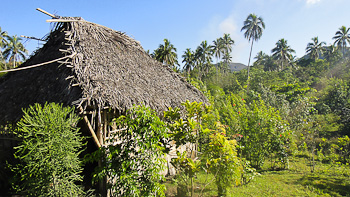
Tenaya
September 2011
Part Ten
Three Days in a
Remote Village
Tanna, Vanuatu
| |
| HOME |
| About Tenaya |
| About Us |
| Latest Update |
| Logs from Current Year |
| Logs from Previous Years |
| Katie's View |
| Route Map |
| Links |
| Contact Us |
![]()
October 2, 2011
Oh my God, this is so cool, I thought as the narrow path through the small village of thatched huts and neatly cropped foliage opened up to a clearing beneath a tree house. The railing, which only exists on one side, was decorated with small clusters of bougainvillea. The grass was short and the fine black dirt, ash I suppose, was raked smooth and clean of leaves. We had arrived at our home for the next two nights.
Because we lead such a nomadic lifestyle, Jim and I never feel as though we are on vacation. Every day is an adventure regardless of where we are. We live in the moment with no thoughts of going home or back to work. We have no home, only where we happen to be. Each day is just another in our traveling lives. But, some days are more exceptional than others and this was turning out to be very exciting indeed.
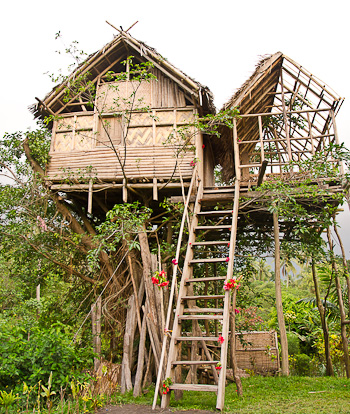
We walked two hours from Port Resolution to reach the traditional village of Ikquramanu on the island of Tanna, Vanuatu. Kelson Jr. met us early in the journey carrying three sticks whose ends had been cut to points. He guided us to the scenic location nestled in a wide verdant valley between Mt. Melon, the high point of the island, and Mt. Yasur, a very active volcano.
At one point along the way, as we walked through the bush on a rutted, dirt road, we heard a chicken clucking. Kelson slowed and listened. "Wild chicken" he said, looking interested. He stopped and listened some more, then asked if we would wait. No problem, we were happy to take a break. Off he ran into the bush, his bare feet moving as quietly and quickly as could be, holding his bush knife up at his side. He returned empty-handed a few minutes later having barely grasped the chicken's wing before it fled.
A few other times during the journey Kelson rapidly fired one of his sharpened sticks high into a tree. It flew end over end in a spiraling motion. The rustling of branches revealed a pigeon barely escaping with its life. Looks like poultry was not in the cards for dinner. I wondered if the reason we'd seen no gulls yet in Vanuatu was that the people ate them. I should have asked.
When we were thirsty he brought down two drinking nuts and cut them open with his knife. Jim and I were carrying 2 liters of water each. All we needed was a long stick and a bush knife!
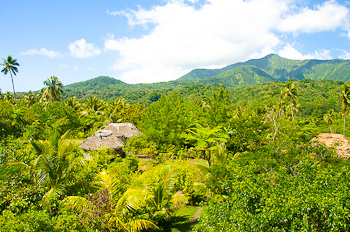
Charlie designed the tree house and built it with Kelson's help. He has no architectural training, or much other formal education for that matter, but he is wise and has a practical mind. His father and oldest brother built and maintain Mountain Breeze Bungalows, and he has designed most of the tree houses in the area. Banyans are plentiful on Tanna and are ideal for tree houses. In a few years the limbs and branches will grow out around this, his most recent creation, to wrap it in a cool, leafy shroud.
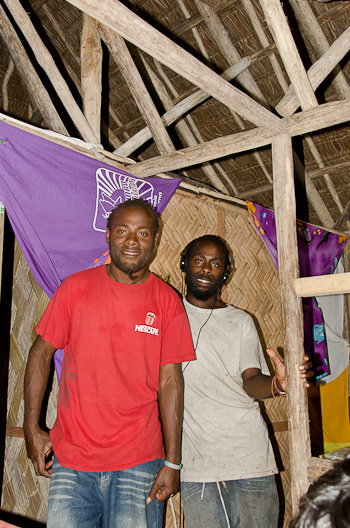
The tree house has two has sleeping rooms and a small living room. Both the living room and room we slept in have amazing views of Mt. Yasur. The red glow in the night sky is absolutely gorgeous.
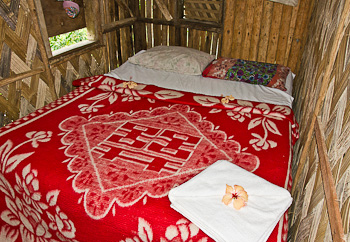
Rumbles deep within Yasur's belly often stir the ground with small quakes causing the tree house to sway slightly. Its floors and timbers are made of banyan roots and the walls are woven pandanus leaves. I believe the only chairs in the village are in the guest quarters. They, too, were handmade.
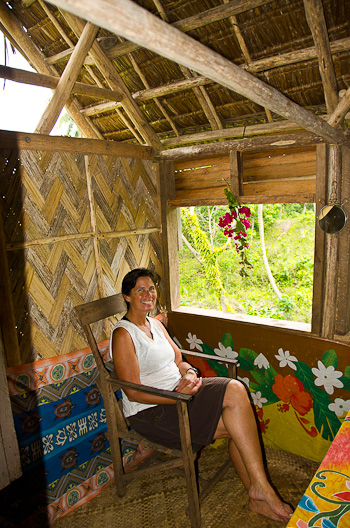
After a tour of the village and pointing out the basic shower and toilet hut nearby, Kelson and Charlie suggested we settle in and rest. Kelson bid us a good night as he left for his job guiding visitors from a resort up to and along the rim of the volcano. We were pleased to be staying in his village and not at the resort.
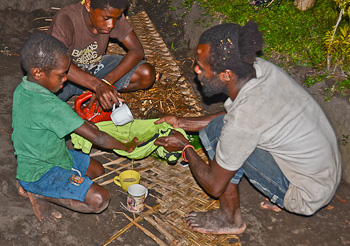
At dusk Charlie and two boys came to the clearing beneath the tree house, laid out a mat and began preparing kava for us. He scraped the cultivated root as best he could with his bush knife before one of the boys rubbed it clean using coconut husks. Then he cut the roots into short, narrow pieces. Next the boys stuffed piece after piece into their mouths and chewed. Pulpy globs were spit onto leaves of wild kava until a small mound formed.
A portion of the pile was placed in the center of an old running singlet. As Charlie and Sam, the youngest boy, held each end, the older boy added water. Charlie and Sam twisted the contents over a cup while the liquid trickled out. The process was repeated for each cup. Honestly, some things are best left up to the imagination, or simply ignored. Anyway, I drank first then Jim, and when the Chief wandered up they fixed him a cup too. When no guests are present the Chief drinks first. The Chief is Charlie's father and Kelson's grandfather.
Our lips barely tingled from this kava, I guess we were given a light dose which was fine after our experience at the circumcision ceremony. We were able to move down to the cooking area in full control of our lower limbs and any saliva flowing after ingesting the vile tasting concoction remained confined to our mouths. Ni-Vans spit like crazy after drinking kava but Jim is not a spitter and I refrained to retain a bit of decorum.
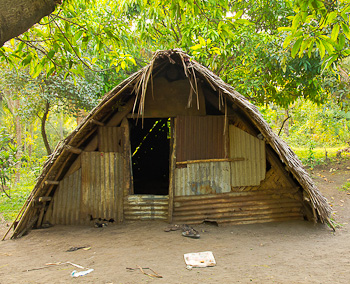
All the other huts and bungalows of the village are built with square walls. The cooking hut has an A-Frame construction which is much stronger and allows the smoke from the fire to rise to a high point. During cyclones this is the gathering place. It has served them well.
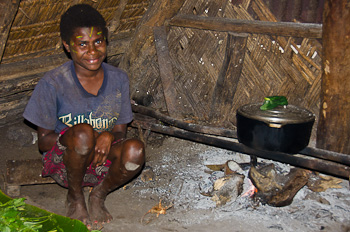
Alice, Charlie's sister, and JoAnne prepared a substantial meal of deliciously flavored cabbage and chaco which was served with rice. I should have learned the recipe! We chose to dine in the cooking hut seated on mats covering the ground rather than in the restaurant reseved for guests. That is how the villagers eat so that is how we wanted to eat.
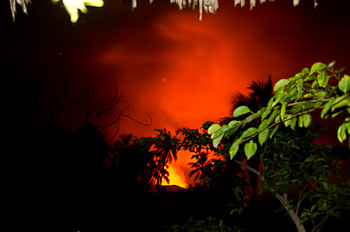
Yasur entertained and enthralled us throughout the night with his spectacular light show. We slept fitfully on the comfortable bed and awoke only at the sound of unfamiliar noises. The same as on Tenaya.
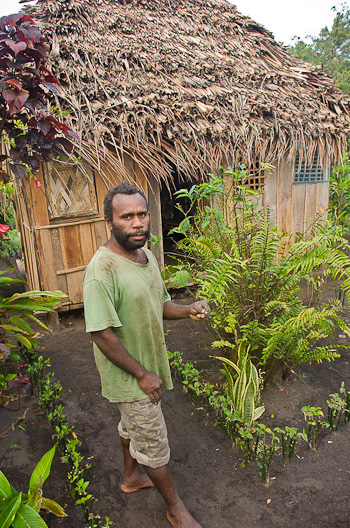
We met Joseph the next morning. He is the Chief's first born and manages the bungalows. He regaled us with fascinating stories and antidotes of his culture.
Holding up a section of fern, he told us that in olden times if the Chief needed to know the number of people gathered he would pass around a long section. Each person would pinch a leaf so that when it returned to the Chief he had an accurate count.
He explained the private wedding ritual where a man and woman, along with a few important people, go to a particular type of tree whose leaves have three sections. The couple pinches off the outer leaves in turn while saying their vows to each other. The center leaf is allowed to grow and flourish. When the pinched leaves grow again their promise lasts.
Should a man have problems keeping his manhood interested in his wife, there is a plant that will re-energize it and make strong again.
He showed us the sprout of a plant that is used for pregnant women to have an easy and clean childbirth.
If someone breaks a bone, leaves from a certain plant will mend it cleanly.
For centuries, if a parrot flys to the village and rests in a tree he is announcing the arrival of a visitor.
When fairy martins fly noisily about it is time to plant.
The volcano points. When it goes one direction it is a good time to go to the sea, a good time to fish ahd dive.
We could have listened to him for hours but Charlie came to fetch us for breakfast at the restaurant, a basic but charming dining room complete with table and chairs.
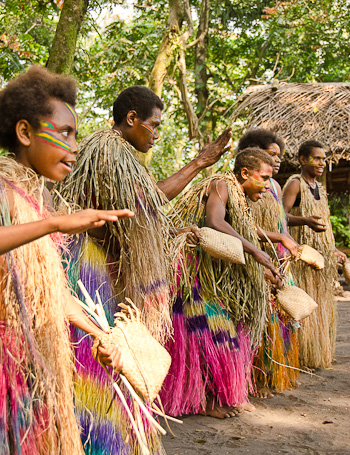
Singing in the distance signaled that it was time for us to witness Napen Napen, the kastom ladies' dances. We followed Charlie through the village and across the street to a large clearing under an impressive banyan. Soon ladies and girls dressed in long, painted grass with painted faces appeared. They clapped one hand against a stuffed instrument made of woven leaves that created a muffled tone as they sang and danced. It was all very exciting and we watched intently, amazed that cultures like this still exist in the world.
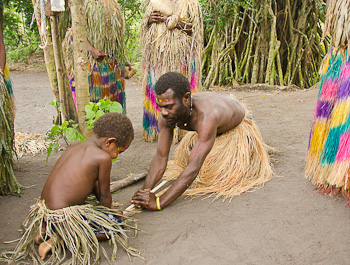
When the dancing had finished a man named Samson and a boy stepped up to demonstrate making fire. He rubbed two branches of wild hibiscus until he got a spark and then nursed it into a flame. The whole process took only a few minutes. Kelson had told us that before there were matches they would try to always keep a fire burning.
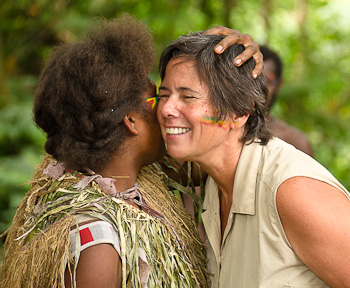
The women seemed in no hurry to leave so I hopped up and did a little dance of my own, clicking my heals together. Their eyes widened as they laughed uproariously and gathered round for a better look. When I stopped someone wrapped a skirt around my waist and Robin painted my face with hers. Then they taught me how to dance properly. It was great fun and the ladies and girls were so incredibly warm and friendly. I would have liked to have spent the entire day with them.
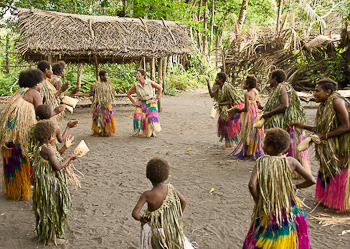
Video: Napen Napen Kastom Ladies Dance
After the Napen Napen Charlie led us down a path away from the village and into the bush. We heard sounds of boars, wild or not we do not know, before we came to an enormous banyan. A pretty chestnut horse greeted us and stayed close like a puppy until Charlie shooed it away. He trains and rides horses and guides horseback trips. As Jim and I walked around the massive tangle of hanging roots, Charlie, Sam and the other boy climbed high into it.
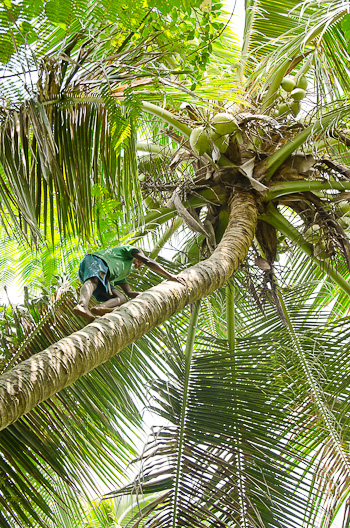
Next it was time for our coconut lessons. Sam climbed a tall palm and released several drinking nuts. Charlie hacked away at these to provide a welcome drink. Then he cut them in half so we could scrape the thin, soft meat from the inside of the shell to eat.
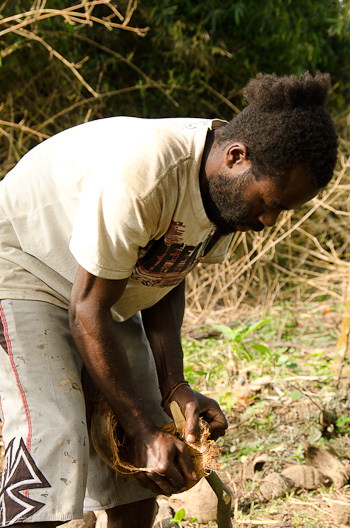
We moved on to a clear section of earth under many coconut palms. Charlie picked up coconuts and listened for a rattle of liquid inside. He gathered about a dozen then produced a stick of bamboo which he cut sharp at both ends. He jammed it into the ground and used it to crack open the outer shells. He taught Jim this and how to do it with a bush knife. Jim really wants a bush knife!
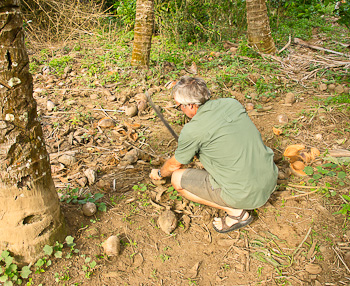
Charlie left little bits of husk clinging to the shells which he used to tie the coconuts together. The bundle was then easily carried over the shoulders using the spiked bamboo stick. These were the coconuts the men would use later to make coconut milk for the laplap, our special dinner.
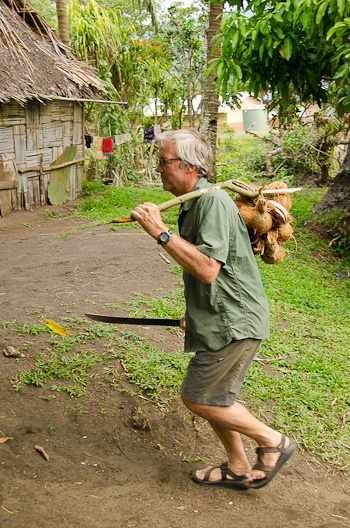
The coconuts were cut in half and the water retained. As this is a man's job, Kelson showed Jim how to grate the flesh of each half with a special tool. Once all was shredded it was mixed with the water and left to soak. This took about thirty minutes to complete!
Their contribution to dinner finished, Kelson, Charlie and Jim walked down to the big clearing where a meeting of three Chiefs was finishing and kava time was beginning. There was not a woman or child in sight.
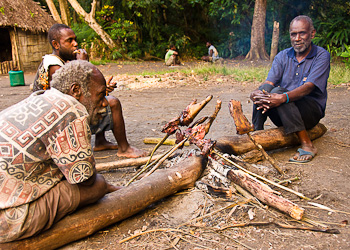
They have a really good way of solving problems within and between the villages. A person brings their complaint to his Chief. If it is with another village, the person with the problem sits on one side and the problem person sits on the other with his Chief. The Chiefs listen to both sides and decide on a verdict.
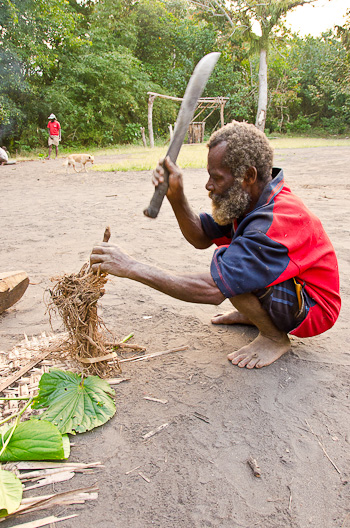
With the problem between the villages solved it was now time to celebrate. Keiapi Kamisak, the head Chief and Charlie's father, whacked away at a chunk of kava root as another Chief, named Jimmy, and the headmaster of the primary school, named John, cooked large portions of a tiny pig skewered on sticks over a fire. These important people had gathered in one part of the vast clearing.
A group of men chopped and prepared kava near the Chiefs, while across the clearing gathered another group of men. This is where Kelson, Charlie and Jim sat. Between the two groups of men, and along the perimeter, was a hut with an opening extending the length of the side facing the clearing.
Soon Jim was invited over to the gathering of Chiefs. As he arrived Charlie's father handed him a small stump to sit on. Everyone else rested on the ground or on logs. Chief Jimmy and John introduced themselves and spoke to him, the only ones that spoke English. The tone was quiet and words were spoken softly and seldom.
When it came time to imbide, Chief Keiapi Kamisak was served first. He walked to a grassy section in the middle of the clearing, turned his back to everyone and downed his bowl. On the way back to the group he stopped at the hut to take a piece of taro from a bowl placed there. When he returned the other two Chiefs did the same in turn. Then Jim. Then John. Then the rest of the men of which there were about twenty. A hush fell over the already quiet gathering.
John began to explain the circumstances of the meeting and soon they wandered away from the group of Chiefs to speak more freely. About this time the kava began to work its magic on Jim. His lips went completely numb and legs began to wobble. John spoke in earnest as they stood. Jim wished for all the world the Chief would bring the stool again. He was not at all sure his legs, which were rapidly turning to rubber, would continue to hold him.
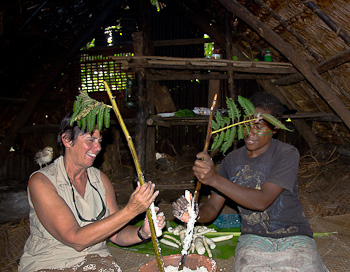
While Jim and the other men were quietly socializing and drinking kava, Alice and JoAnne taught me to make laplap, the national dish.
Alice and JoAnne had already peeled all the manioc tubers so my job was to help grate them. About two dozen tubers. Using a stick. With leaves sprouting out the top. On the floor of the kitchen. With a baby chick bouncing about and making baby chick sounds. The branches had hard, pointy welts all over; no metal gadgets for these women. The branch worked well but I still managed to contribute a little of my own flesh to the bowl by grating the first knuckle of my middle finger several times.
Once the manioc had been grated JoAnne kneaded it while Alice and I reached for handfuls of the coconut shreds soaking in their water. We squeezed the milk, and this is how coconut milk is made in the village, over large banana leaves spread evenly like paper preparing to wrap a present.
In the darkness of the unlit kitchen I had not noticed the paint on Alice's and JoAnne's faces. Not until the flash lit up the room did I realize that they had been two of the dancers that morning. Indeed, JoAnne had been my dance instructor!
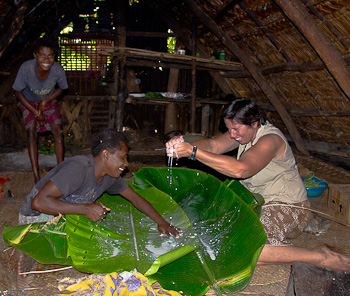
Once flavored with the coconut milk the glutinous manioc was plopped onto the leaves and smoothed to an even thickness. Alice maneuvered it around while endlessly patting it with her folded fingers. She creased the leaves to create sharp edges and patted some more. When she was happy with the result we folded the leaves over to close the package and tied it with long, sinewy fibers.
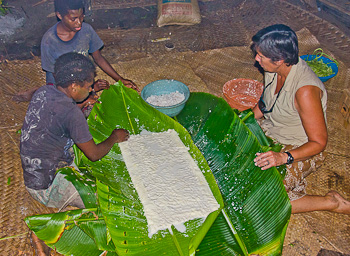
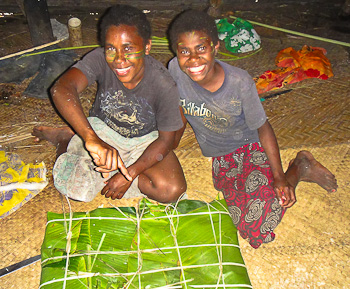
JoAnne carried it out and, after much preparation to get the hot stones just right, placed it on the outside fire. Then she, Alice, and Alice's mother the Chief's wife, covered it with big, round leaves. Hot stones, some wood and more stones were placed on top. Here it would cook for a couple of hours.
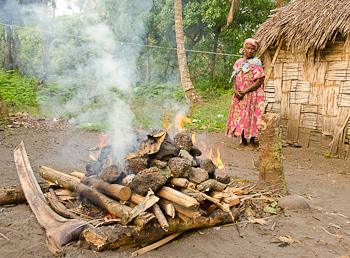
Earlier in the day Charlie asked if we would like a cooked pig with our laplap. Sure! The price was 1000 vatu, about $12USD. We had never bought a pig before and a little pork sounded tasty. So off we went down a path to Sam's house to buy a pig from his father. Turns out his father was at the meeting in the big clearing so Charlie would have to procure it later. As we walked back to the tree house we stopped by a stall with a female pig in it. She was fairly large and I wondered if we would get a pig that size. We could feed the entire village and then some! Charlie motioned to a tiny white piglet running in and out of the enclosure. I thought he meant to show us how cute it was. Little did I realize that we would be dining on this adorable little creature that night.
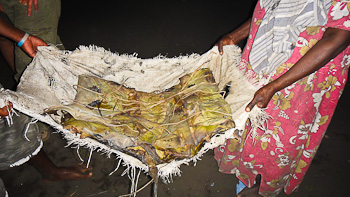
The cooked laplap and pig were brought into the kitchen, cut into serving sized pieces and placed in bowls along with rice and cooked cabbage. We were told to dig in. When we were nearly finished the Chief joined us and loaded a plate. The women and Kelson just looked on with no plates and no food.
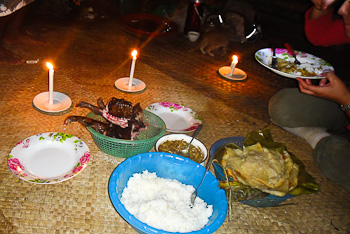
When we were finished eating Kelson said he would translate for the Chief if we had any questions to ask him. Eventually the subject turned to cannibalism.
Land has always been very important to the people of Vanuatu. It is passed from father down to son. Should someone come on another's land, it was perceived as aggressive behavior to take the land. The man must be killed.
Killed, yes. But why eaten? A shrug of the shoulders and look as if to say, "It's dead, it's meat, what else would you do with it?" Simple answer, really.
When asked if they ate the meat of other men for some specific purpose such as to attain strength or power from them, Kelson and the Chief conferred a moment and then answered no. They just ate them. In hindsight, I wish I would have asked the chief if he had ever dined on enemies. He is 72 and cannibalism certainly has been practiced in his lifetime. Being the eldest son of the existing Chief before becoming Chief himself, I would assume he or his family had been presented a person or two.
Kelson explained that human flesh would keep a long time because they stuffed it inside bamboo and kept it over a low fire. In my mind I drew a cartoon of a large diameter stick with fingers and toes hanging out the ends roasting over an open fire.
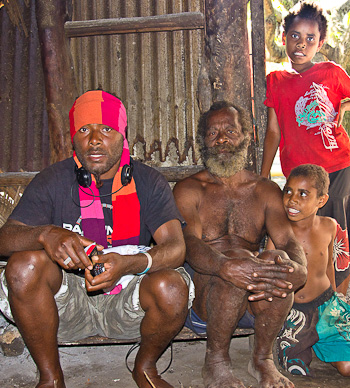
In the morning Kelson and the Chief joined us while we ate our breakfast in the kitchen. As we were leaving that morning, we gave them each a small gift for the huge gift they had given us by allowing us to be a part of their village and for sharing their culture with us. The Chief gave Jim a special armband of woven fiber worn only by Chiefs.
While we talked, Alice brought in a coconut branch and began weaving the leaves. I watched intently. In a few minutes she had made a basket for carrying food. I'd been admiring these baskets since we visited Tonga and was so happy when she gave it to me.
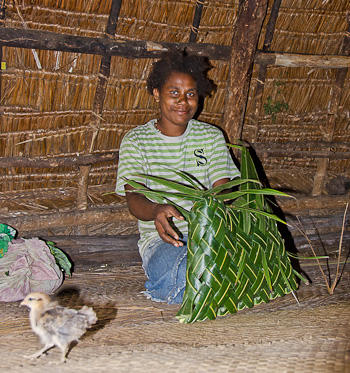
It was sad to leave the kind people of Ikquramanu. We had learned and seen so much but there was still so much more. We didn't get a chance to go horseback riding with Charlie or walk up to visit Yasur again. We didn't get to hike deep in the bush or camp near the cave at the foot of Mt. Melon. We didn't have time to realize we had scores of unanswered questions. But we did make some new friends and were extended an invitation to return. We definitely plan to come back here!
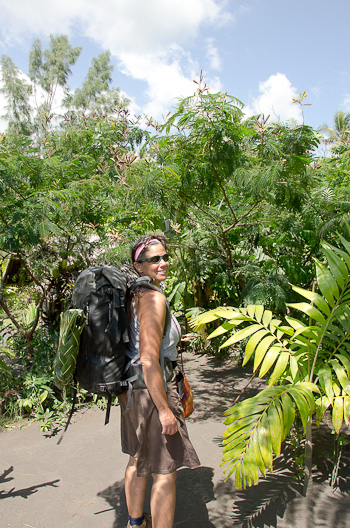
Before leaving the area we stopped at the primary school to say good-bye to John and give him some school supplies. He was happy to see we were walking and not taking a truck back to Pt. Resolution.
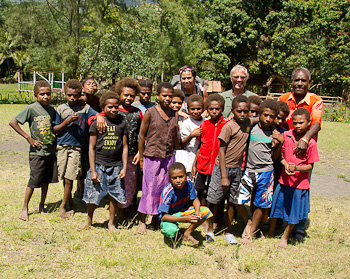
Kelson and Charlie escorted us back to Pt. Resolution toting their bush knives. We stopped once to snack on wild raspberries while Kelson told us the story of Mt. Yasur.
Jim had promised a rope to Charlie and he was keen to see Tenaya. They helped carry the dinghy down to the water and prepared to get in still wielding their knives. Oh no, those were not going in our rubber boat! Jim and I are not used to maneuvering around long, sharp cutting devices while looking for bommies with two extra bodies in the dinghy. They looked around and stashed the knives carefully in some bushes.
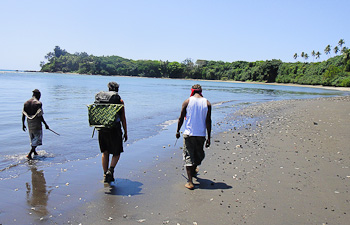
"Sunday August 7, 1774. In the night the Volcano threw up vast quantities of fire and Smoak (sic), the flames were seen to ascend above the hill between us and it, the night before it did the same and made a noise like that of thunder.....and brought such vast quantities of fine sand or ashes that everything was covered with it..." More from the journals of Capt. Cook.
Indeed, we found the same thing when we returned to Tenaya. The wind must have shifted directions while we were away to send the floating debris belched out of Yasur spewing right over the anchorage. Tenaya was covered in a not-so-thin layer of fine ash.
Once Kelson and Charlie were dropped off at the beach after their visit on board, Jim, who was not feeling well, fell fast asleep on the couch and I swept the entire deck with a tiny tent brush and dust pan. To make matters worse, an army of large red ant-like creatures with wings had moved in and taken up residence in the lines and sheets. I swept and squashed and flung bugs overboard for two hours before I allowed myself to dive into the refreshing water. Aaahh.... the end of our most interesting adventure yet.
Photo Gallery: Ikquramanu Village, Tanna, Vanuatu
Go to September 2011 Part Eleven - My Friend Marie
Photo Gallery: Vanuatu Children